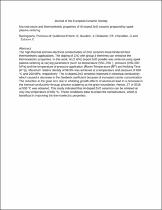 ResearchSpace
ResearchSpace
Microstructure and thermoelectric properties of Al-doped ZnO ceramic prepared by spark plasma sintering
JavaScript is disabled for your browser. Some features of this site may not work without it.
- ResearchSpace
- →
- Research Publications/Outputs
- →
- Journal Articles
- →
- View Item
| dc.contributor.author |
Radingoana, Precious M

|
|
| dc.contributor.author |
Guillemet-Fritsch, S

|
|
| dc.contributor.author |
Noudem, J

|
|
| dc.contributor.author |
Olubambi, PA

|
|
| dc.contributor.author |
Chevallier, G

|
|
| dc.contributor.author |
Estourn, C

|
|
| dc.date.accessioned | 2023-03-17T08:36:14Z | |
| dc.date.available | 2023-03-17T08:36:14Z | |
| dc.date.issued | 2022-10 | |
| dc.identifier.citation | Radingoana, P.M., Guillemet-Fritsch, S., Noudem, J., Olubambi, P., Chevallier, G. & Estourn, C. 2022. Microstructure and thermoelectric properties of Al-doped ZnO ceramic prepared by spark plasma sintering. <i>Journal of the European Ceramic Society.</i> http://hdl.handle.net/10204/12677 | en_ZA |
| dc.identifier.issn | 0955-2219 | |
| dc.identifier.issn | 1873-619X | |
| dc.identifier.uri | https://doi.org/10.1016/j.jeurceramsoc.2022.10.034 | |
| dc.identifier.uri | http://hdl.handle.net/10204/12677 | |
| dc.description.abstract | The high thermal and low electrical conductivities of ZnO ceramics have hindered their thermoelectric applications. The doping of ZnO with group 3 elements can enhance the thermoelectric properties. In this work, Al (2 at%) doped ZnO powder was sintered using spark plasma sintering at varying parameters (such as temperature (550–700 ), pressure (250–500 MPa) and the temperature of pressure application (Room Temperature (RT) and Holding Time (HT))). Maximum relative density of 98.9% was achieved at a temperature and pressure of 650 °C and 250 MPa, respectively. The Al-doped ZnO ceramics improved in electrical conductivity which caused a decrease in the Seebeck coefficient because of increased carrier concentration. The reduction in the grain size due to inhibiting growth effects of aluminum lead to a decrease in the thermal conductivity through phonon scattering at the grain boundaries. Hence, ZT of 0016 at 500 °C was obtained. This study indicated that Al-doped ZnO ceramics can be sintered at very low temperature of 650 °C. These conditions allow to retain the nanostructure, which is beneficial in improving the thermoelectric properties. | en_US |
| dc.format | Abstract | en_US |
| dc.language.iso | en | en_US |
| dc.relation.uri | https://www.sciencedirect.com/science/article/pii/S095522192200810X | en_US |
| dc.source | Journal of the European Ceramic Society | en_US |
| dc.subject | Aluminum | en_US |
| dc.subject | Ceramics | en_US |
| dc.subject | Spark plasma sintering | en_US |
| dc.subject | Thermoelectric properties | en_US |
| dc.subject | ZnO | en_US |
| dc.title | Microstructure and thermoelectric properties of Al-doped ZnO ceramic prepared by spark plasma sintering | en_US |
| dc.type | Article | en_US |
| dc.description.pages | 1009-1016 | en_US |
| dc.description.note | © 2022 Elsevier Ltd. All rights reserved. Due to copyright restrictions, the attached PDF file only contains the abstract of the full text item. For access to the full text item, please consult the publisher's website: https://www.sciencedirect.com/science/article/pii/S095522192200810X | en_US |
| dc.description.cluster | Manufacturing | en_US |
| dc.description.impactarea | Powder Metallurgy Technologies | en_US |
| dc.identifier.apacitation | Radingoana, P. M., Guillemet-Fritsch, S., Noudem, J., Olubambi, P., Chevallier, G., & Estourn, C. (2022). Microstructure and thermoelectric properties of Al-doped ZnO ceramic prepared by spark plasma sintering. <i>Journal of the European Ceramic Society</i>, http://hdl.handle.net/10204/12677 | en_ZA |
| dc.identifier.chicagocitation | Radingoana, Precious M, S Guillemet-Fritsch, J Noudem, PA Olubambi, G Chevallier, and C Estourn "Microstructure and thermoelectric properties of Al-doped ZnO ceramic prepared by spark plasma sintering." <i>Journal of the European Ceramic Society</i> (2022) http://hdl.handle.net/10204/12677 | en_ZA |
| dc.identifier.vancouvercitation | Radingoana PM, Guillemet-Fritsch S, Noudem J, Olubambi P, Chevallier G, Estourn C. Microstructure and thermoelectric properties of Al-doped ZnO ceramic prepared by spark plasma sintering. Journal of the European Ceramic Society. 2022; http://hdl.handle.net/10204/12677. | en_ZA |
| dc.identifier.ris | TY - Article AU - Radingoana, Precious M AU - Guillemet-Fritsch, S AU - Noudem, J AU - Olubambi, PA AU - Chevallier, G AU - Estourn, C AB - The high thermal and low electrical conductivities of ZnO ceramics have hindered their thermoelectric applications. The doping of ZnO with group 3 elements can enhance the thermoelectric properties. In this work, Al (2 at%) doped ZnO powder was sintered using spark plasma sintering at varying parameters (such as temperature (550–700 ), pressure (250–500 MPa) and the temperature of pressure application (Room Temperature (RT) and Holding Time (HT))). Maximum relative density of 98.9% was achieved at a temperature and pressure of 650 °C and 250 MPa, respectively. The Al-doped ZnO ceramics improved in electrical conductivity which caused a decrease in the Seebeck coefficient because of increased carrier concentration. The reduction in the grain size due to inhibiting growth effects of aluminum lead to a decrease in the thermal conductivity through phonon scattering at the grain boundaries. Hence, ZT of 0016 at 500 °C was obtained. This study indicated that Al-doped ZnO ceramics can be sintered at very low temperature of 650 °C. These conditions allow to retain the nanostructure, which is beneficial in improving the thermoelectric properties. DA - 2022-10 DB - ResearchSpace DP - CSIR J1 - Journal of the European Ceramic Society KW - Aluminum KW - Ceramics KW - Spark plasma sintering KW - Thermoelectric properties KW - ZnO LK - https://researchspace.csir.co.za PY - 2022 SM - 0955-2219 SM - 1873-619X T1 - Microstructure and thermoelectric properties of Al-doped ZnO ceramic prepared by spark plasma sintering TI - Microstructure and thermoelectric properties of Al-doped ZnO ceramic prepared by spark plasma sintering UR - http://hdl.handle.net/10204/12677 ER - | en_ZA |
| dc.identifier.worklist | 26549 | en_US |





